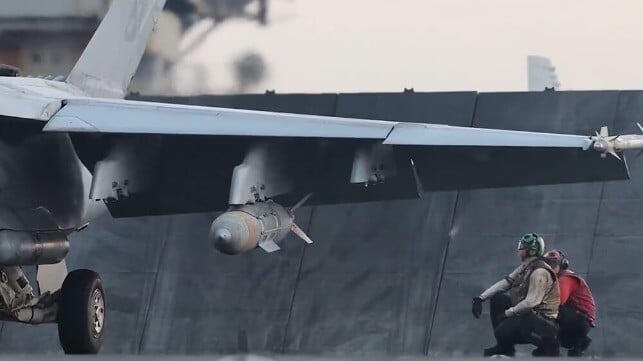Fight With Houthis Left a Dent in U.S. Navy's Weapons Inventory

The extended Red Sea campaign against Yemen's Houthi rebels exposed gaps in the U.S. Navy's supply chain for precision weapons, the service's top officer told a House committee on Wednesday. U.S. Navy warships launched hundreds of high-end air defense missiles at inbound Houthi threats over the past year, and the service has deployed an unpublicized number of Tomahawk cruise missiles and other land-attack munitions during counterattacks. During the Trump administration's intensified strike campaign - March 15 through May 6 - the U.S. expended at least $1 billion worth of weaponry in 1,100 airstrikes.
Those strikes have created a dent in the U.S. Navy's weapons inventory that the defense industrial base will struggle to ramp up to refill, Chief of Naval Operations Adm. James Kilby said earlier this week.
“Precision-guided, long-range munitions like Tomahawk, Long Range Anti-Ship Missile, the heavyweight torpedo, all those ammunitions we need to increase production on,” he told the House Appropriations Committee, per Military Times. “But I’m also of the mind that we need to look at other vendors. They may not be able to produce the same exact specifications, but they might be able to produce a missile that’s effective, which is more effective than no missile.”
At top of mind is the need to deter China, the U.S. Navy's primary strategic competitor. According to the New York Times, the burn rate on Navy weapons stocks - and the vulnerability that this created in the event of a Pacific conflict - was one of the many factors behind the White House's decision to cease hostilities with the Houthis.
“If we go to war with China, it’s going to be bloody and there’s going to be casualties and it’s going to take plenty of munitions. So our stocks need to be full," Kilby told the committee.
The White House's Red Sea strike campaign was designed to last 8-10 months, according to the Times; it was called off with a truce after less than two, even though the Houthis continued to launch attacks on Israel. The reasons for the shortened campaign went beyond missile inventories.
The Houthis turned out to be difficult to combat. During the operation, Houthi attacks forced the carrier USS Harry S. Truman to take sudden evasive action at least once, resulting in the loss of an F/A-18 fighter over the side. In action over Yemen, high-tech U.S. forces never established full command of the airspace: The Houthis' rudimentary air defense systems took down about half a dozen MQ-9 Reaper drones, nearly hit several F-16 fighters, and forced one advanced F-35 stealth strike fighter to make evasive maneuvers. And even after weeks of U.S. airstrikes, the group retained some residual ability to carry out long-range ballistic missile attacks.
"They [the Houthis] took tremendous punishment. And, you know, you could say there's a lot of bravery there, that it was amazing what they took," said President Donald Trump, discussing the ceasefire last week.
Recent evidence suggests that the group is rearming and rebuilding, and it continues to launch ballistic missiles at targets in Israel, including three attempted attacks reported earlier this week. Even attacks on shipping still appear to be on the table: In a statement Thursday, Houthi spokesman Yahya Saree said that until Israel ends its operation in Gaza, the group will keep up a "maritime navigation ban in the Red and Arabian Seas."
